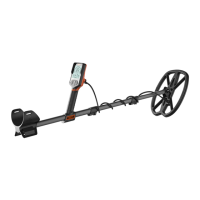13
directly tied to how efficiently you locate and recover targets. The better you can differentiate between good
and bad targets and the faster you can pinpoint and recover them, the more you will have to show for your
efforts at the end of the day.
PROPER SEARCH TECHNIQUES
The proper search technique will make a big difference in how successful you are in the field. Your sweep
speed as well as how high you hold the coil off the ground are essential in getting the most out of your
detector.
As far as coil height, the best recommendation is to scrub the ground with the coil. There is a coil cover on
the bottom of the search coil designed to protect the coil itself and if you need to replace it, the cost is minimal.
Remember, if you are able to detect an average-sized coin 8 inches away from the coil and you are holding
the coil 4 inches above the ground, you have just cut your detection depth in half before you even passed
over your first target.
When it comes to sweep speed, try to keep the speed around 2 to 3 seconds from one side to the other.
While your detector will pick up a target sweeping much faster, it will tire you out in short order and creates
the chance that you will miss a target. Since the Quest detectors use Double-D coils, you do not have to
overlap each sweep as much as you would with a concentric coil but some overlap is recommended to ensure
you do not miss passing the coil over all targets in your search area.
CAUTION: The circuit in the Q30 series requires that the search coil be in motion in order for a target to be
detected. If you slow down too much trying to pinpoint the target without activating the pinpoint circuit, the
signal will disappear leading you to believe there is nothing there. Rather than slowing your sweep speed to
almost nothing, try wiggling the coil side-to-side no more than an inch or two as this will prevent you from
losing the signal.
If you are new to the hobby of metal detecting or you are not familiar with how the Q30 series responds, try
tossing targets including coins and trash on the ground and sweep the coil over them while holding it a few
inches above them (see Testing the Response of Your Q30 / Q30+ above).
PROSPECTING
When using your Q30 / Q30+ for prospecting, GOLD 1 or GOLD 2 will be the preferred search modes due to
their sensitivity to small targets. Headphones are highly recommended so that you can hear the subtle
changes in the threshold which often indicates a small or deep target. Adjust the audio threshold (see Page
6 for details) so that you can hear slight changes easily but not having it so loud as to drown out any changes.
The setting will vary based on the headphones used, your personal hearing preferences and the external
noise that may be present; i.e., wind, birds, leaves, etc. Be sure to test the detector’s response to small
targets such as fishing sinkers, .22 caliber bullets, BBs, an earring back, etc. Practicing on these before you
head out looking for metallic minerals such as gold and silver will eliminate frustration and ensure you are
successful in your searches.
TIP: Using GOLD 1 or GOLD 2 when searching the dry sand regions of swimming beaches can help you find
fine gold jewelry such as earrings, chains, charms and small, thin rings. Use the detector the same way you
would when prospecting . . . use headphones, adjust the audio threshold and listen for weaker signals which
can indicate the type of targets that beach hunters are searching for.

